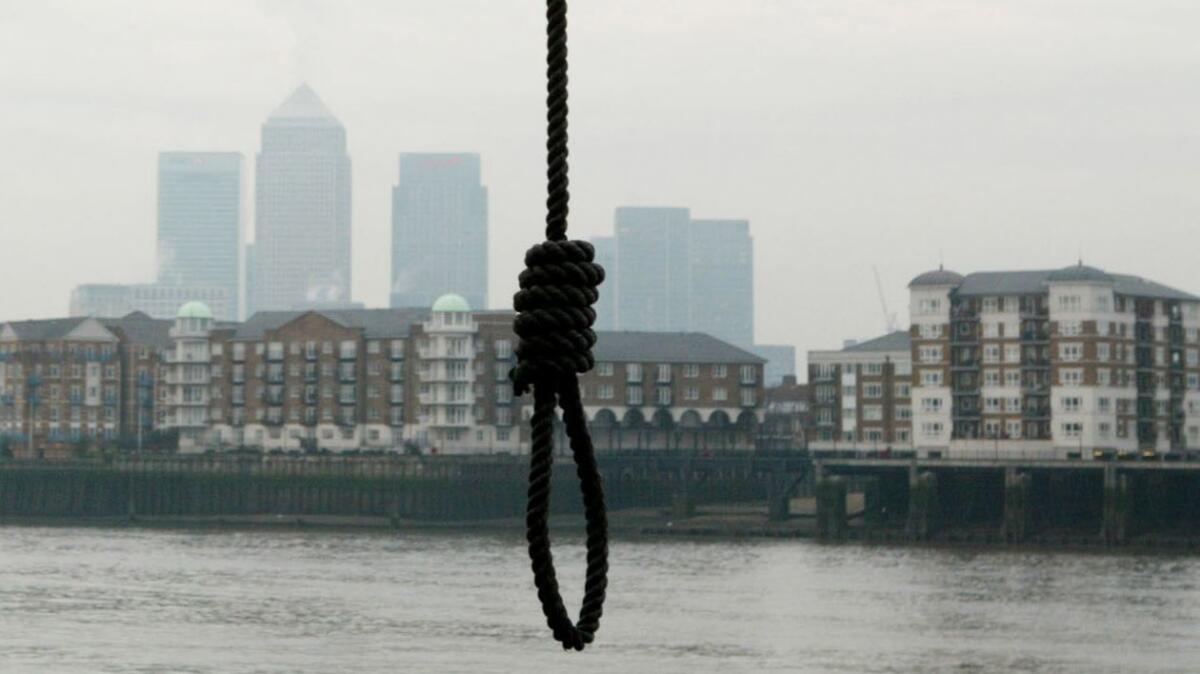Op-Ed: New York’s last public execution, months before the Civil War, has lessons for today

- Share via
The last public execution in New York City took place on Friday, July 13, 1860, the summer before the start of the Civil War. The hanging took place on Bedloe’s Island in New York Harbor, where a crowd of 12,000 had turned out for the spectacle.
Public hangings were, at the time, a regular occurrence in the city. A tree at the northeast corner of Washington Square Park was known as Hangman’s Elm, and the Marquis de Lafayette said he’d seen 20 highwaymen swing in the park on a visit to Manhattan. At Executioner’s Corner – 13th Street and 2nd Avenue – hangings were carried out in an empty field.
The events were often unruly. In 1824, for example, a crowd of 50,000 revelers turned out for the public hanging of John Johnson, a hotel-keeper who murdered one of his guests. And the public spectacles often seemed to have the opposite of their intended effect: Instead of somber events to deter people from crime, the hangings became parties. Meant to encourage right and punish wrong, they became excuses for drinking and debauchery.
Today, U.S. executions are more private, though they still occur regularly. In Alabama on Thursday, 46-year-old Christopher Lee Price was killed with a lethal injection for stabbing a Fayette County minister to death in 1991. The execution, the second in Alabama in May, was witnessed by relatives of Price’s victim.
But even today’s more private executions remain controversial, with the nation deeply divided by the death penalty. The Supreme Court is also split on the issue. In a recent case, the court rejected the petition of Russell Bucklew, who claimed the method chosen for his execution (lethal injection) would, due to a rare disease, cause him pain that violates the Constitution’s 8th Amendment, which forbids cruel and unusual punishment. Justice Neil M. Gorsuch, writing for the majority, argued that the Constitution prohibits the state from inflicting “terror, pain, or disgrace” unnecessarily, but does not promise a “painless death.” Justice Stephen G. Breyer, the court’s fiercest opponent of capital punishment, has written about how, after a long career in law, he’s come to suspect that “there simply is no constitutional way to implement the death penalty.”
The last public execution in New York City was of Albert Hicks, a pirate.
The last public execution in New York City was of Albert Hicks, a pirate. In 1860, he joined the crew of the E.A. Johnson, an oyster sloop docked at Spring Street on the Hudson River. He waited until the boat neared Staten Island, then, taking an ax from the wall, killed everyone on board and dumped their bodies. When the police searched the decks, they found four fingers and a thumb, which the killer had overlooked in the dark.
The ensuing manhunt was a huge newspaper story, and Hicks was finally tracked to a boardinghouse in Providence, R.I. He was captured, returned to Manhattan and tried for piracy in federal court. By that time, the state of New York had quit holding public executions, but the federal government had no such ban, and many New Yorkers wanted to see Hicks hang. Three weeks after his conviction, the prisoner was taken to Bedloe’s Island to be executed.
Hicks, who had undergone a religious conversion after his conviction, approached his execution with tremendous stoicism, but the day itself turned out to be one of the wildest in New York City history. When he got to the island, tens of thousands of spectators on boats anchored in the harbor watched as he dropped to his knees on the beach, prayed for a minute, stood and spoke his last words. “Hang me quick – make haste.”
The executioner, standing beside the scaffold, slipped a black hood over the pirate’s head, secured a rope around his neck, then pulled the lever. At 11:15 a.m., the weights dropped and Hicks was yanked 20 feet into the air. His neck snapped at the third vertebra. His body danced at the end of the rope for three minutes, then was still. At 11:20, his body jerked once more – wildly – then was still again. A few minutes later, the hands of the pirate and the neck below the hood turned purple.
Enter the Fray: First takes on the news of the minute »
The events of July 13, 1860, may seem gruesome, but many recent executions in the United States have also been unnerving, if less public. Take the 2018 lethal injection of Alabama prisoner Doyle Lee Hamm. Officials spent more than two hours searching for a suitable vein, leaving a dozen puncture wounds in Hamm’s arms and groin before calling it quits. Or the 2014 execution of Ohio prisoner Dennis McGuire, who struggled for 25 minutes after being injected. According to a lawsuit filed by the family, McGuire suffered “repeated cycles of snorting, gurgling and arching his back, appearing to writhe in pain.” Or the 1997 electrocution of Florida prisoner Pedro Medina, when a tower of flame shot out of his head and the chamber filled with smoke. In “Gruesome Spectacles: Botched Executions and America’s Death Penalty,” Amherst professor Austin Sarat reports that, of 8,776 executions carried out in the United States between 1890 and 2010, 276 (3.15%) were “botched.”
The way we treat the condemned may in time seem as barbaric as the way Albert Hicks was treated in 1860. The fact that the same island, under a new name, has for decades been the home of the Statue of Liberty, needs no additional comment.
Rich Cohen is the author, most recently, of “The Last Pirate of New York: A Ghost Ship, a Killer and the Birth of a Gangster Nation.”
More to Read
A cure for the common opinion
Get thought-provoking perspectives with our weekly newsletter.
You may occasionally receive promotional content from the Los Angeles Times.









